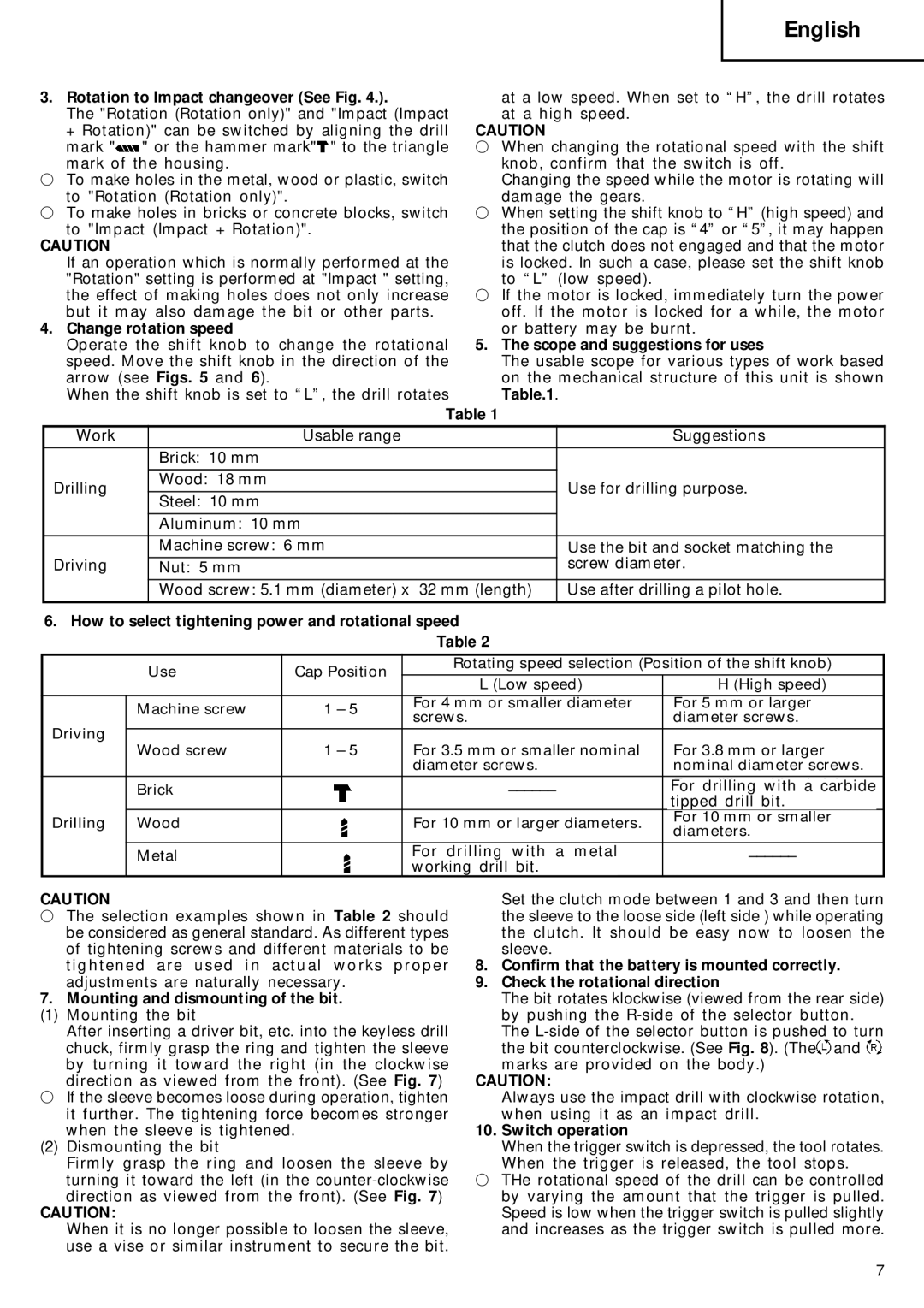
English
3.Rotation to Impact changeover (See Fig. 4.).
The "Rotation (Rotation only)" and "Impact (Impact + Rotation)" can be switched by aligning the drill
mark "![]() " or the hammer mark"
" or the hammer mark"![]() " to the triangle
" to the triangle
mark of the housing.
◯To make holes in the metal, wood or plastic, switch to "Rotation (Rotation only)".
◯To make holes in bricks or concrete blocks, switch
to "Impact (Impact + Rotation)".
CAUTION
If an operation which is normally performed at the "Rotation" setting is performed at "Impact " setting, the effect of making holes does not only increase but it may also damage the bit or other parts.
4.Change rotation speed
Operate the shift knob to change the rotational speed. Move the shift knob in the direction of the arrow (see Figs. 5 and 6).
When the shift knob is set to “L”, the drill rotates
at a low speed. When set to “H”, the drill rotates at a high speed.
CAUTION
◯When changing the rotational speed with the shift knob, confirm that the switch is off.
Changing the speed while the motor is rotating will damage the gears.
◯When setting the shift knob to “H” (high speed) and the position of the cap is “4” or “5”, it may happen that the clutch does not engaged and that the motor is locked. In such a case, please set the shift knob to “L” (low speed).
◯If the motor is locked, immediately turn the power off. If the motor is locked for a while, the motor
or battery may be burnt.
5.The scope and suggestions for uses
The usable scope for various types of work based on the mechanical structure of this unit is shown Table.1.
|
| Table 1 |
|
|
| Work | Usable range | Suggestions |
|
|
| Brick: 10 mm |
|
|
| Drilling | Wood: 18 mm | Use for drilling purpose. |
|
|
|
| ||
| Steel: 10 mm | |||
|
|
|
| |
|
|
|
|
|
|
| Aluminum: 10 mm |
|
|
|
| Machine screw: 6 mm | Use the bit and socket matching the |
|
| Driving | Nut: 5 mm | screw diameter. |
|
|
|
|
|
|
|
| Wood screw: 5.1 mm (diameter) x 32 mm (length) | Use after drilling a pilot hole. |
|
6.How to select tightening power and rotational speed Table 2
| Use | Cap Position |
| Rotating speed selection (Position of the shift knob) | ||||
|
|
|
| L (Low speed) |
| H (High speed) | ||
| Machine screw | 1 – 5 |
| For 4 mm or smaller diameter |
| For 5 mm or larger | ||
|
| screws. |
| diameter screws. | ||||
Driving |
|
|
|
| ||||
Wood screw | 1 – 5 |
| For 3.5 mm or smaller nominal |
| For 3.8 mm or larger | |||
|
|
| ||||||
|
|
|
| diameter screws. |
| nominal diameter screws. | ||
| Brick |
|
|
| For drilling with a carbide |
| ||
|
|
|
|
|
|
| tipped drill bit. |
|
Drilling | Wood |
|
| For 10 mm or larger diameters. |
| For 10 mm or smaller | ||
|
|
| diameters. | |||||
|
|
|
|
|
|
| ||
| Metal |
|
| For drilling with a metal |
|
| ||
|
|
| working drill bit. |
|
| |||
|
|
|
|
|
|
|
| |
CAUTION
◯The selection examples shown in Table 2 should be considered as general standard. As different types of tightening screws and different materials to be tightened are used in actual works proper
adjustments are naturally necessary.
7.Mounting and dismounting of the bit.
(1) Mounting the bit
After inserting a driver bit, etc. into the keyless drill chuck, firmly grasp the ring and tighten the sleeve by turning it toward the right (in the clockwise direction as viewed from the front). (See Fig. 7)
◯ If the sleeve becomes loose during operation, tighten
it further. The tightening force becomes stronger when the sleeve is tightened.
(2)Dismounting the bit
Firmly grasp the ring and loosen the sleeve by turning it toward the left (in the
CAUTION:
When it is no longer possible to loosen the sleeve, use a vise or similar instrument to secure the bit.
Set the clutch mode between 1 and 3 and then turn the sleeve to the loose side (left side ) while operating the clutch. It should be easy now to loosen the sleeve.
8.Confirm that the battery is mounted correctly.
9.Check the rotational direction
The bit rotates klockwise (viewed from the rear side) by pushing the
the bit counterclockwise. (See Fig. 8). (The![]() and
and ![]() marks are provided on the body.)
marks are provided on the body.)
CAUTION:
Always use the impact drill with clockwise rotation, when using it as an impact drill.
10. Switch operation
When the trigger switch is depressed, the tool rotates. When the trigger is released, the tool stops.
◯THe rotational speed of the drill can be controlled by varying the amount that the trigger is pulled. Speed is low when the trigger switch is pulled slightly and increases as the trigger switch is pulled more.
7
